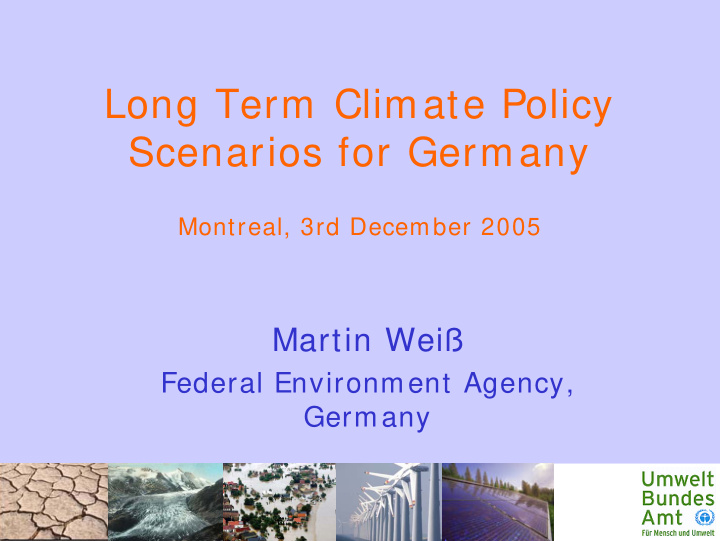



Long Term Climate Policy Scenarios for Germany Montreal, 3rd December 2005 Martin Weiß Federal Environment Agency, Germany
Warming in Germany
Source: Meinshausen 2 0 0 5 Stabilisation Scenarios
Common but differentiated Responsibility 400 ppmv 2020 450 ppmv 2020 C&C 50% 50% C&C CDC CDC Mutistage 40% Mutistage Triptych 30% Triptych Reference 30% Reference 20% 10% 10% -10% 0% -10% -30% -20% -30% -50% -40% -50% -70% R+EEU R+EEU GER JPN EU25 GER JPN EU25 FRA UK RAI FRA UK RAI USA USA 400 ppmv 2050 450 ppmv 2050 C&C C&C 60% 60% CDC CDC Mutistage Mutistage 40% Triptych 40% Triptych Reference Reference 20% 20% 0% 0% -20% -20% -40% -40% -60% -60% -80% -80% -100% -100% R+EEU R+EEU GER JPN EU25 GER JPN EU25 FRA UK FRA UK RAI USA RAI USA
Effect of current policies Industry incl. process emissions Manufacturing, trade and services Households Transport (w/o intern. aviation) Energy Non-CO 2 gasses
GHG Reduction Targets
Cost is Function of Energy Prices Cost in billion € p.a.
Cutting Energy demand by 50% by 2050
Electricity Supply
Heat production
Transport Fuels
Conclusions • Germany: 40% in 2020 and 80% in 2050 is technically feasible and economically viable • Reduce energy demand to 50% and increase share of renewables to 50% • Success stories: EEG and ETR • New: Emissions trading has to be strengthened to contribute
Thank You! martin.weiss@uba.de www.umweltbundesamt.de/ klimaschutz www.klimaschuetzen.de www.fiacc.net
Recommend
More recommend